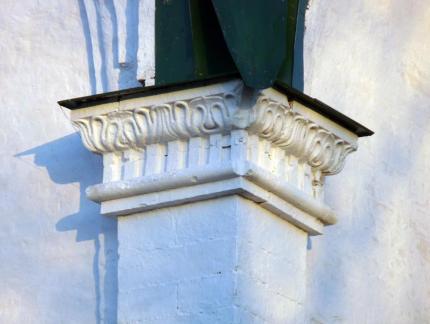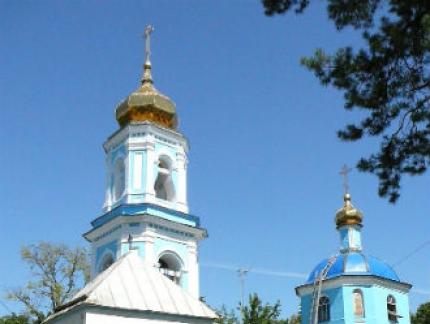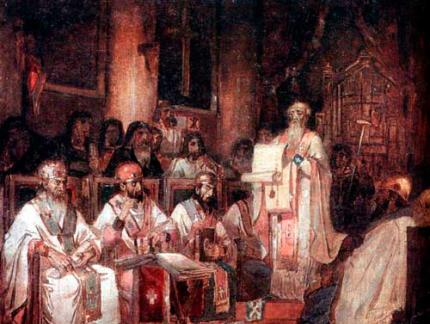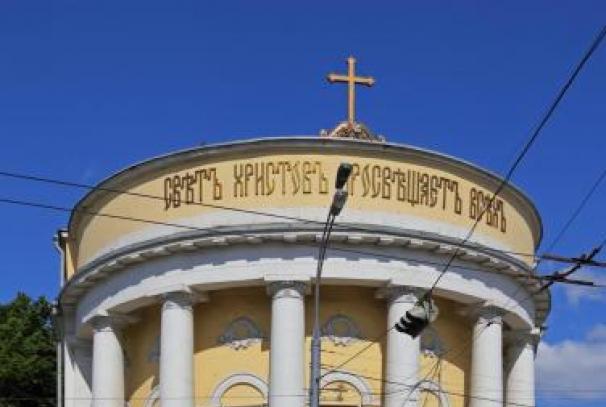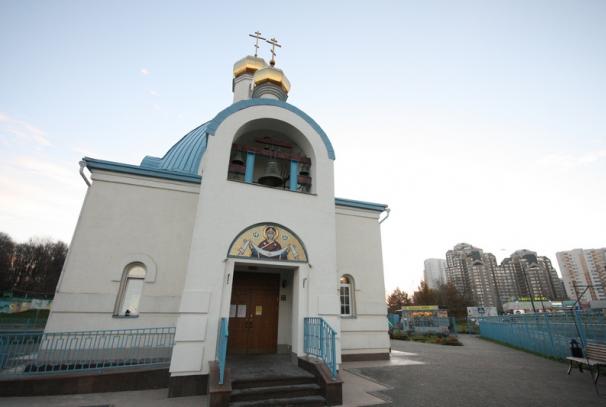Sofia Assumption Cathedral. Saint Sophia Cathedral tobolsk
Sophia Cathedral undoubtedly one of the most impressive ancient structures Tobolsk. It was built in 1683-1686 by Moscow and Ustyug masons led by apprentices Gerasim Sharypin and Gavrila Tyutin. Tobolsk Sofia - the first stone church building in Siberia. Despite its age, the cathedral looks young and elegant today. This is a wonderful example of Russian national architecture. Saint Sophia Cathedral is a massive square-shaped structure with five chapters, the middle of which stands out for its size. Golden stars shine on a blue background of the chapters. The walls of the cathedral are cut through two tiers of large windows decorated with columnar platbands with spectacular keeled finishes. The eastern half of the temple from the side of the altar is flooded with light penetrating not only through the windows of the walls, but also the light openings of the drums.
The eye is attracted by the pattern of molding in the window frames, decorative cornice belts, good proportions and asymmetry in the arrangement of the windows, the cornice completion in the form of an arched zakomara. The western main gate of the Sophia-Uspensky Cathedral is striking in its unusual design and amazing engraved ornament. Lush decoration has three entrance portals on the north, west and south sides. They are framed with curly masonry, which gives rich chiaroscuro. Forged iron doors with an elegant notch successfully contrast with the calm grandeur of the walls. The cathedral is the dominant building of the architectural ensemble of the Kremlin. The size of the structure is significant. Inside, the length from the western wall to the eastern one is 30.7 m, and the width from the northern to the southern wall is 18.7 m. The wall thickness is 2.16 m. The greatest height of the internal space from the floor to the arch of the central drum is 28.6 m. General height with a cross - 47 m. The cathedral with three low altar apse is completed with five chapters on oval-shaped drums. The main drum (“neck”) of a chapter with a diameter of 7.5 m has a height of 7.4 m and 8 narrow light window openings, and small drums have 2 each. Contemporaries of the 17th century the interior of the cathedral was striking: the “marvelous” multi-tiered carved iconostasis with many icons in expensive salaries, and bright wall paintings. From whatever point you look at the cathedral, you can feel the volume and massiveness everywhere, it appears before you in its three-dimensionality, almost like a sculpture, which is clearly facilitated by its clearly pronounced silhouette composition. The cathedral is very well placed, on the highest place of the Trinity Mountain, and therefore is well visible from all sides. Its white silhouette, which stands out against the sky, dominates the space. For a long time, the cathedral served as the tomb of the Tobolsk bishops and metropolitans, and seven of their burials are located under its floor. This cathedral is famous not only for its architecture. For Tobolsk, it had the same ideological significance as the Assumption Cathedral in the Moscow Kremlin. St. Sophia Cathedral played an important role as a spiritual and cultural center. The annals of Siberia were written in the walls of the majestic temple, decisions that influenced, at times, the fate of all of Russia were highlighted here. The Sofia court and the St. Sophia Cathedral are inseparable in a purely historical sense: in a matter of years, on the threshold of the 18th century, a complete architectural complex was formed.
Of course, much has been transformed here in three centuries. But even in the midst of the new environment, St. Sophia Cathedral is still undeniably soloing, supported by the powerful vertical of the bell tower, and the masses of the same courtyard of the St. Sophia Court, bounded by fortress walls, correspond to its masses. Asymmetric, free composition of space - with all its apparent involuntaryness - actually offers our perception a complex rhythm. That is why many people have the feeling that in the Sofia court you can hear the ancient stones saying. And that's why everyone is able to experience the force of gravity of the primeval severity of Sofia. The history of the creation of St. Sophia Cathedral In 1621, a Siberian archbishopric was formed in Tobolsk. The first archbishop Kiprian, having arrived in Tobolsk, chose for his court the place where the first Tobolsk prison had once stood. Here were erected farm buildings, which surrounded the "bastion". Cyprian quickly built a cathedral church, which was given the name - Sophia. Throughout the church, the entire archbishop's court occupied a relatively small area and did not reach the southern cliff of the Trinity Cape. Thus, already at the end of the first quarter of the 17th century, two urban centers actually took shape on Cape Trinity. In the western part - administrative, where public services were located. In the east - spiritual, where the cathedral and archbishop's buildings were located. And the section between them went through the natural log - Vzvoz. It, as the axis of symmetry, has been preserved for centuries. He exists in our time. But the conditional architectural "specific gravity" of the administrative and spiritual centers has changed over time. It can be seen from the foregoing that in the 80s of the 17th century, the city walls weakened - instead of chopped walls, a prison was built. And at the same time, the strengthening of the spiritual center began. After the fire of 1680, Metropolitan Pavel the First turned to the king with a request to build a stone cathedral. Soon permission was received from Moscow for the construction of a stone cathedral church: "... the Cathedral Church of St. Sophia of God’s Wisdom to build a stone against the sample, which is in the Kremlin in the Kremlin in the Maiden’s Monastery ...". Estimated paintings, measurements and drawings of the Ascension Monastery in the Moscow Kremlin were sent to Tobolsk as a model for the construction of the cathedral. The main cubic volume of the temple ended with barriers and was crowned with five domes. As in the cathedral of the Ascension Monastery, the necks of its heads are decorated with thin arched-columnar belts. There are similarities in the decoration of window frames, in the processing of portals. To give greater structural strength, its four massive pillars are shifted to the eastern wall, leaving a large free space from the west. In 1681, the construction of the stone St. Sophia Cathedral began on the site of a wooden one, burned down in 1677. It arose as an ordinary religious building, and the organizer of the business, Metropolitan Pavel, first of all pursued his interests: to affirm Orthodoxy in Siberia. Pavel obtained permission to use the Siberian sovereign peasants (who were considered free, that is, did not know serfdom) in construction on a regular basis. At the head of the stone artel was stone business journeyman Vasily Larionov. In 1684, the builders had already completed the main drum, but here "there are pillars at the church and the whole pade is inward." During the construction in 1684, almost erected to the top, the cathedral collapsed - the vaults supporting the main dome fell. Nevertheless, the work was completed, and in October 1686 the first stone church of Siberia was consecrated in the name of the Assumption of the Mother of God. The Cathedral traditionally has a double name: Sophia-Assumption, in memory of the wooden Sophia Cathedral, which was founded by the first bishop of Tobolsk, Novgorod Cyprian in 1621 year. History has preserved the names of those who built the cathedral, crowned with a powerful five dome. The Muscovites Vasily Larionov, Gerasim Sharypin and Gavrila Tyutin with the assistants and artels of experienced masons who arrived from the capital erected the building of the main temple of the Siberian Metropolis. Five masons and twenty bricks from Ustyug the Great came here. Stone construction in the Sofia courtyard continued. In 1686-1688, near the cathedral was built the "Holy Gate" with the gate church of St. Sergius of Radonezh. A little south erected a stone bell tower. And after that, they began the construction of stone walls around the entire Sofia court. Seven round and two square towers were built and connected by battlements of stone walls. 
For ten years, stone walls were built with a total length of about 620 m. The height of the walls was 4.3 m. The construction of the walls and towers was led by stone apprentices: the north and east - Gavrila Savelyev son Tyutin, and the south and west - Gerasim Yakovlev son Sharypin. Both were hereditary masons. Both came to Tobolsk from Moscow "for every stone building." And the first thing they were subjected to in a hut - they took "hand-made skaits" from them, - in our opinion, professional written guarantees, "so as to confirm the foundation firmly with such a fortress, so that in many years no damage and ruin would be repaired." Treasury stone construction in those years was carried out centrally, and the most competent, experienced, knowledgeable personnel - mainly from Moscow masons - were in the service in the Order of stone affairs. Here the main detachment of the "apprentices of stone affairs" was concentrated. And it must be emphasized: in the XVI-XVII centuries the word carried a slightly different meaning, was more significant than in later times. “Apprentice of stone affairs” did not necessarily mean “assistant craftsman”, this title could also be referred to as talented builders, independent construction managers. The heterogeneity of the concept of "apprentice." To be absolutely accurate, according to the latest data, which Susanna Vasilyevna Kopylova cites in her book “Stone Building in Siberia”, five apprentices arrived to build the Sofia Court, but two of them — Ivan Smirny and Vasily Kashinets — did not leave noticeable trace; they were simply technicians, headed masons' artels at relatively small objects: laid stoves and a hearth in a bakery and a cookhouse, laid cellars and dried them, bottled the base under the porch. It is not for nothing that Gavrila Tyutin notes that neither Smirny nor Kashinets “how many supplies should be understood”, that is, they cannot calculate the estimate. I must say that it was precisely the ability to draw up “rosette paintings” that distinguished then apprentices of high rank from ordinary masons. In its original form, St. Sophia Cathedral did not stand for long. Soon he lost the curtains, the coating was replaced with a four-gable roof. In 1704, for the winter service (since the cathedral was not heated), a small stone “warm” aisle was added to the northwestern corner of the cathedral. Metropolitan John Maksimovich (ruled the Siberian Metropolis in 1711-1715) was buried in it. The fire of 1723 caused the first major repair of the building. In 1751, the burnt chapel was dismantled and a new chapel was built along the entire northern wall of the cathedral (in the name of John Chrysostom). Then an octagonal drum with a heavy baroque head appeared over the altar of the chapel, against the northern portal of the cathedral. The central part of the aisle with a gilded cross is the only north porch (the porch in front of the church entrance) that has been preserved so far. In 1759, the gate with the church was dismantled (located next to the cathedral, to the south of it), and in 1780 a one-story brick bell tower fell apart. Repeatedly changed the shape and coverage of the heads of the cathedral. The fire of 1723 destroyed simple onion chapters.
After 1726, the cathedral was covered with iron on the new rafters and changed the shape of its chapters. They received a baroque silhouette close to the shape of the chapters to Ukrainian architecture. And today the Tobolsk temple is completed with chapters with interception at the base. By the bicentennial of the city, in 1786-1787, the wooden rafters were replaced by iron, covered the domes with a white sheet iron instead of a simple one, and made crosses and makovitsa on a large chapter. A painting depicting Christ and the twelve apostles appeared on the central drum. The roof of the cathedral was then painted green. All blacksmithing work, coating and dyeing of roofs and gilding of chapters was performed by local craftsmen - the Novgorodtsev brothers. At the same time, the entire southwestern corner of the cathedral was relocated and a new porch was built. At the same time, in the yard of Sofia in 1787, the construction of two-story stone buildings of a consistory and a monastic building was completed. And then St. Sophia Cathedral changed its original appearance. In 1796, the two-story building of the sacristy adjoined the southeast corner and, connecting with the passage to the altar, became part of the cathedral building. The old one-story sacristy existed already in the first half of the 18th century as an extension to the northeast corner of the cathedral. A new cathedral sacristy was built on the site of monastic cells at the same time as the new bell tower of the cathedral. The sacristy of St. Sophia Cathedral had a rather large collection of church services and works of applied art of high art. It contained old printed and manuscript books of the 17th-19th centuries of church and secular content. The three-tier cathedral bell tower, white under a green dome, was built in 1794-1797.
The bell tower is one of the last buildings of the Tobolsk Kremlin, its highest vertical. Its height with a cross is 65 m. The bell tower of St. Sophia Cathedral was famous for its melodious ringing. Thirteen bells hung on two tiers of ringing. Among them was a bell weighing 1011 pounds (16.5 tons), made in 1738 at the Tagil factory of Akinfiy Demidov. The "tongue" of this bell weighed fifty-one pounds - more than eight hundred kilograms. A thick raspberry ringing rang far around, was heard for tens of kilometers. For his loud voice, the main bell was nicknamed the Siberian Tsar Bell. The interior of the cathedral also changed. Already in 1710, the original iconostasis was replaced by a new one. In the XVIII century, fresco painting adorned the cathedral. In 1862, the walls and arches of the cathedral and the altar were painted yellow and painted with oil paints. The heavy cubic mass of the cathedral, the proportionate, calm harmony of its powerful drums with high chapters - the epitome of grandeur. The impression of monumentality is achieved by the laconicism of the main volume of the building, by its large articulations and by a distinct silhouette composition. In the summer of 1978, gilding of figured superstructures with openwork crosses was restored, which is why the wedding of the cathedral acquired a special outfit. Graceful portals of the cathedral. Perspectively located arches are decorated with archivolts and numerous “melons”. And what a delicate patterned drawing made by hand notching for iron, are the forged gates of the main entrance of Sofia with stripes laid on them! The door from the main (western) entrance to the cathedral was not here by 1961 ... It was found by Moscow restoration engineer Fedor Georgievich Dubrovin. Found in a pile of garbage when he dismantled an extension to the southern facade. In its lifetime, the cathedral underwent significant changes: it was rebuilt, “filled up” with extensions, updated, but invariably pleased the eye, attracted to itself.
The walls of Tobolsk were witness to many historical changes and achievements. Sophia-Assumption Cathedral - The most valuable and unique monument of Russian architecture in Siberia. Of course, restore the original appearance with almost accurate accuracy St. Sophia Cathedral, for which completeness was characteristic, is a truly laborious process. But what an honor and responsibility it is to revive anew the masterpiece of church architecture on Tobolsk land. There is no other similar architectural monument, original in beauty, in Siberia.
“The cathedral church was founded in the summer of 1681, but construction began only in April 1683 after the artel of Ustyug builders arrived and experienced masons sent from Moscow headed by apprentice Vasily Larionov” (1)
The cathedral began to be built under Metropolitan Pavel, the former confessor of Tsarevna Sophia, “at the place where the wooden Sophia Church (second in a row) was burnt down in 1677 ... Ascension Church of the Chudov Monastery was used as a model.” (2)
“The model ... carried two cultural traditions - the Old Russian and Italian Renaissance, since the Moscow Ascension Church, built in 1519 by the Italian Aleviz Novy, burned and was thoroughly rebuilt under Boris Godunov in the middle of the 16th century. Therefore, the influence of the principles of Renaissance architecture was reflected in the St. Sophia Cathedral only in the emphasized geometry of the cubic volume. The completion of the temple and the decoration of the facades were solved in Old Russian ...
The architecture of the Tobolsk Sophia Cathedral was certainly influenced by the building traditions of Ustyug masters, as well as the traditions of the Russian “pattern” brought by the Moscow masters and the then Naryshkinsky baroque. ”(1)
In 1686, the cathedral “was consecrated in the name of the Assumption of the Virgin, but later, both orally and in church documents, it was called Sophia, Assumption, and Sophia-Assumption. In 1704, a small chapel was added to the north side of the cathedral in the name of Anthony and Theodosius of the Caves. In the middle of the XIX century it was redone and extended along the entire northern wall, consecrated in the name of John Chrysostom. In the crypt of the chapel are the graves of the Tobolsk metropolitans. ” (2)
In the photo in the book of S.P. Zavarikhin Cathedral stands under a four-pitched roof. The author writes: “We do not know whether constructive zakomaras have ever existed. Most likely, given the harsh climate, they were abandoned even during the construction process or immediately after its completion. But the chapters are known for sure that they were built onion (although the Moscow Ascension Church had helmet-shaped domes), and in 1726 they were replaced by more complex ones, with interceptions at the base, similar to Ukrainian ones. We can assume that this alteration was done at the behest of the famous Siberian Metropolitan Filofei Leshchinsky, a graduate of the Kiev Theological Academy. ” (1)
The reconstruction of Sofia began in the 1970s. At first, the domes turned blue with gold stars (this can be seen in the pictures of 2002), then the back coating was returned. In 2003 - 2006 the cathedral was again restored. The central chapter was first gilded, and on the west side, instead of a promising portal, a stone porch, built here in the middle of the 19th century, was recreated.
The western wall of the Sofia side of the Kremlin is not limited to the Sophia-Assumption Cathedral. The cathedral sacristy adjoins it, and behind it - the bell tower and the Intercession Cathedral. But about this interesting complex - next time.
Small photographs were taken in 2002, the second in 2004, the rest in 2009.
________________________________________ ____________________________________
Sources:
1. Zavarikhin S.P. In the ancient center of Siberia. - M .: Art, 1987
2. Kozlova-Afanasyeva E.M. The architectural heritage of the Tyumen region. Catalog. - Tyumen: Publishing house Art, 2008

Sophia-Assumption Cathedral
Tobolsk Sophia-Assumption Cathedral - the oldest temple in Siberia. This is a real masterpiece of church architecture on Tobolsk land, the most valuable and greatest unique architectural monument.
Almost 4 centuries ago, the first wooden Sophia Cathedral was built in Tobolsk. The cathedral burned down in 1643. In his place, His Grace Gerasim laid the new, also wooden cathedral, which also burned down in 1677. In 1680, responding to the request of Metropolitan Paul the First, Sovereign Fedor Alekseevich ordered the construction of a new cathedral, but already in stone. But the construction of the first stone cathedral was unsuccessful. He stood for a little over a year. The disproportion of the internal pillars and the severity of the head and arches of the temple led to the fact that the entire upper part collapsed inside the cathedral. The newly begun construction work ended only two years later. After the construction was completed in 1686, the new cathedral was consecrated by Metropolitan Paul already in honor of the icon of the Assumption of the Mother of God. Hence the double name went - Sophia-Assumption Cathedral.
For more than three centuries, the Sophia-Assumption Cathedral has changed its internal and external appearance several times. The reason for this was not only fires. The cathedral was rebuilt several times, "overgrown" with new extensions. The interior of the cathedral also changed. Already in 1710, the original iconostasis was replaced by a new one. In 1862, the frescoes decorating the cathedral were painted yellow, the walls and arches of the temple were painted with oil paints. For a long time after the end of the October Revolution, the main temple of Siberia was closed and used for other purposes. From the beginning of the 30s until the start of World War II, a grain warehouse was located in the Church of the Assumption of the Mother of God. Then the cathedral was simply empty and began to collapse.
In 1961, the cathedral building was transferred to the Tobolsk Museum-Reserve. Restoration work has begun. Domes were repaired, walls were plastered, and floors were filled with concrete. In the summer of 1978, gilding of figured superstructures with openwork crosses was restored, which is why the wedding of the cathedral acquired a special outfit. But the work was very slow. So that by the beginning of the eighties were not completed. After repeated requests from the Archbishop of Omsk and Tyumen Theodosius in 1988, the Sophia-Assumption Cathedral was transferred to its rightful owner - the Russian Orthodox Church. Restoration work began, which transformed and changed the appearance of the main temple of Siberia. The temple was equipped with underfloor heating and a special heating system, which allowed regular worship services to be held.
Since 2003, after a visit to Tobolsk by the President of the Russian Federation V.V. Putin decided to restore all the shrines of the Tobolsk Kremlin and make the city of Tobolsk one of the tourist cities of Russia. In 2004, the capital restoration of the Sophia-Assumption Cathedral began: the foundation of the temple is strengthened, wall paintings are being restored, a new iconostasis is being formed, the icons for which are painted by students and teachers of the icon painting school at the Tobolsk Theological Seminary. The restoration work of the sacristy of the cathedral is underway. The walls of the sacristy are also painted by students and teachers of the icon painting school.
Naturally, it is very difficult to restore the original appearance of the cathedral with full certainty, but it invariably pleases the eye and attracts to itself. The cathedral is very well placed on the highest place of the Trinity Mountain, and therefore is well visible from all sides. Its white silhouette, which stands out against the sky, dominates the space. Golden stars shine on a blue background of the chapters.
“The cathedral church was founded in the summer of 1681, but construction began only in April 1683 after the artel of Ustyug builders arrived and experienced masons sent from Moscow headed by apprentice Vasily Larionov” (1)
The cathedral began to be built under Metropolitan Pavel, the former confessor of Tsarevna Sophia, “at the place where the wooden Sophia Church (second in a row) was burnt down in 1677 ... Ascension Church of the Chudov Monastery was used as a model.” (2)
“The model ... carried two cultural traditions - the Old Russian and Italian Renaissance, since the Moscow Ascension Church, built in 1519 by the Italian Aleviz Novy, burned and was thoroughly rebuilt under Boris Godunov in the middle of the 16th century. Therefore, the influence of the principles of Renaissance architecture was reflected in the St. Sophia Cathedral only in the emphasized geometry of the cubic volume. The completion of the temple and the decoration of the facades were solved in Old Russian ...
The architecture of the Tobolsk Sophia Cathedral was certainly influenced by the building traditions of Ustyug masters, as well as the traditions of the Russian “pattern” brought by the Moscow masters and the then Naryshkinsky baroque. ”(1)
In 1686, the cathedral “was consecrated in the name of the Assumption of the Virgin, but later, both orally and in church documents, it was called Sophia, Assumption, and Sophia-Assumption. In 1704, a small chapel was added to the north side of the cathedral in the name of Anthony and Theodosius of the Caves. In the middle of the XIX century it was redone and extended along the entire northern wall, consecrated in the name of John Chrysostom. In the crypt of the chapel are the graves of the Tobolsk metropolitans. ” (2)
In the photo in the book of S.P. Zavarikhin Cathedral stands under a four-pitched roof. The author writes: “We do not know whether constructive zakomaras have ever existed. Most likely, given the harsh climate, they were abandoned even during the construction process or immediately after its completion. But the chapters are known for sure that they were built onion (although the Moscow Ascension Church had helmet-shaped domes), and in 1726 they were replaced by more complex ones, with interceptions at the base, similar to Ukrainian ones. We can assume that this alteration was done at the behest of the famous Siberian Metropolitan Filofei Leshchinsky, a graduate of the Kiev Theological Academy. ” (1)
The reconstruction of Sofia began in the 1970s. At first, the domes turned blue with gold stars (this can be seen in the pictures of 2002), then the back coating was returned. In 2003 - 2006 the cathedral was again restored. The central chapter was first gilded, and on the west side, instead of a promising portal, a stone porch, built here in the middle of the 19th century, was recreated.
The western wall of the Sofia side of the Kremlin is not limited to the Sophia-Assumption Cathedral. The cathedral sacristy adjoins it, and behind it - the bell tower and the Intercession Cathedral. But about this interesting complex - next time.
Small photographs were taken in 2002, the second in 2004, the rest in 2009.
________________________________________ ____________________________________
Sources:
1. Zavarikhin S.P. In the ancient center of Siberia. - M .: Art, 1987
2. Kozlova-Afanasyeva E.M. The architectural heritage of the Tyumen region. Catalog. - Tyumen: Publishing house Art, 2008
The earliest building of the Sofia court is the Sophia-Assumption Cathedral (1686). Its construction is connected with the organization of the Siberian Metropolis. The cathedral was thought of as the main building of Siberia. The prototype of the cathedral is the Ascension Cathedral of the Moscow Kremlin. St. Sophia Cathedral was built like cross-domed churches, which were spread in Russia. In the 18th century, two additions were made to the cathedral - the northern Zlatoust limit and the sacristy - the repository of church utensils.
The oldest stone building in Siberia. The stone Sofia Assumption Cathedral was built under Metropolitan Paul I; Before his appointment in Tobolsk, he was the archimandrite of the Moscow Chudov Monastery in the Kremlin and was in charge of the construction of churches and monasteries, as well as the confessor of Princess Sophia. In response to his request in 1680, a tsar’s letter was sent, where Sovereign Theodore Alekseevich pointed out "... to put a stone church on public money ... so that the cathedral church does not stand for monetary poverty ...".
The building was ordered "against the model in Moscow in the Kremlin in the Ascension Monastery of the girl." By June 1684 the cathedral was almost built: a large drum was already laid out. But the pillars could not stand it - the arch collapsed at night on June 27. A year later, construction resumed. October 27, 1686 the consecration of the stone cathedral "in memory of the Assumption of the Mother of God." But the former name - Sophia - is preserved in the tradition of its name. By the time of the consecration of the cathedral, the iconostasis was ready, which included the image of Sophia, the Wisdom of God, and the image of the Assumption in the ancient writing.
By that time, the icons were already painted in icon-painting workshops at the bishop's house. Inside, the cathedral is striking in its massive pillars, deliberately thickened after the collapse of the arches. And still his space is enormous. In 1710, by a personal decree of Peter I, 1,000 rubles were allocated from the treasury for the construction of a new carved iconostasis, called "marvelous" for its splendor. The Ukrainian masters who arrived with Metropolitan Filofei (Leshchinsky), working on the iconostasis, created an outstanding work of art and brought European Siberian traditions to Siberia. In 1930, all churches in Tobolsk were liquidated. The black page in the history of St. Sophia Cathedral is the content of exiled and dispossessed families.
At this time, the iconostasis and church utensils disappeared without a trace, the crosses were removed. Then the cathedral was used as a granary. But already in 1939, the art department under the Council of People's Commissars began to deal with the identification of architectural monuments and their registration. Since 1940, the monuments of history and culture of Tobolsk were certified and transferred to the balance of the museum. In 1991, St. Sophia Cathedral again departed from the diocese and was re-consecrated in 1995. Nowadays there is no building in all of Siberia that is older than the white-stone five-headed Tobolsk St. Sophia Cathedral. For almost three hundred years it was the cathedral of the archbishops and metropolitans of Tobolsk and all Siberia and their tomb, there are seven graves under the floor.
Sophia - Assumption Cathedral was built (1683-1686) by Moscow and Ustyug masons led by apprentices Gerasim Sharypin and Gavrila Tyutin. The height of the cathedral is 47 m, the wall thickness is about 2 m. It is known that it was built on the model of five-domed cubic temples, widespread in monasteries. As an example, the architect was ordered to be guided by the drawing of the Cathedral of the Ascension Monastery in the Moscow Kremlin.
The cathedral is famous not only for its architecture. For Tobolsk, it had the same ideological significance as the Assumption Cathedral in the Moscow Kremlin. With the arrival of the first Archbishop Cyprian, the name of Ermak and his associates was forever recorded in the synod of St. Sophia Cathedral and every year, in the first week of Lent, their names were pronounced from the pulpit. Their feats of arms were commemorated.
Under the auspices of St. Sophia, the first annals of Siberia were created, the foundations of spiritual and secular enlightenment were laid. Many socially important ceremonies took place in the cathedral with a large gathering of people, the "great things" of Siberia were accomplished. The strength of the spiritual authority of St. Sophia Cathedral was such that sermons sometimes not entirely acceptable to the government were delivered from his pulpit.

